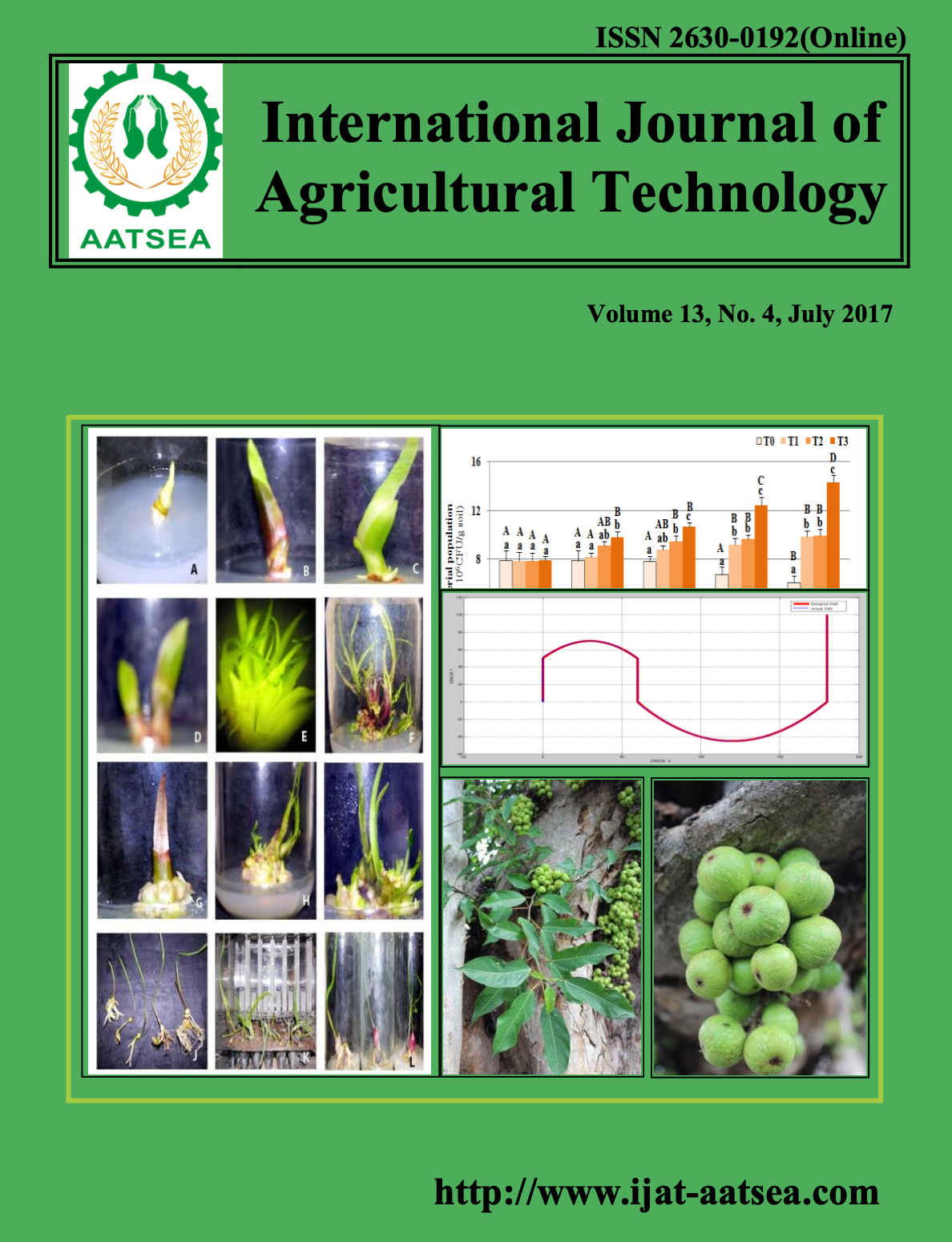Biocontrol of Fusarium wilt disease of cucumber (Cucumis sativus L.) in greenhouse and field
Main Article Content
Abstract
The bacteria present around the rhizosphere, suppress diseases and promotes plant growth are known as plant growth promoting rhizobacteria (PGPR). PGPR are ecofriendly, stimulate the plant growth factors and reduce the incidence of crop diseases as well as supply the nutrients for growth of plants. 13 PGPR strains, 9 were isolated from cucurbit rhizosphere from fields, three from MTCC assessed for positive rapid screening bioassay were used for the seed priming and further tests. The potting mixture was sterilized for 1h at 1210C at 15-18 psi for two consecutive days before use. Both the soil samples were checked for their micronutrient content, conductivity, water holding capacity and also important macronutrients. The soil samples were loamy with good water holding capacity, with adequate macronutrients (NPK) and micronutrients. In the field tests and greenhouse, the treated seeds of Cucumis sativus were compared for their vine length, node number of first female flower, fruits number/ plant,fruit weight in grams, diameter of the fruit in centimeter, total yield / 6 fruits in gram and growth conditions to the control. In 13 PGPR strains tested only Bacillus amyloliquefaciens MIC6 and Pseudomonas aeruginosa MTCC2581 showed maximum germination and yield manages Fusarium wilt both in greenhouse as well as in field conditions.
Article Details

This work is licensed under a Creative Commons Attribution-NonCommercial-NoDerivatives 4.0 International License.
References
Abdul-Baki, A. A. and Anderson J. D. (1973). Vigour determination in soybean seed by multiple criteria. Crop Science 13:630-633.
Anjanappa, M., Venkatesha, J. and Kumara, B. S. (2012). Growth yield and quality attributes of cucumber (Cv. Hassan local) as influenced by in the field tests and greenhouse, the primed seeds of cucurbit were compared for their growth characters and growth conditions to the control. Integrated nutrient management grown under protected condition. Vegetable Science 37: 47-50.
Ashraf, M. and Iram, A. (2005). Drought stress induced changes in some organic substances in nodules and other plant parts of two potential legumes differing in salt tolerance. Flora 200:535-546.
Bafti, S. S., Bonjar, G. H. S., Aghighi, S., Biglari, S., Farrokhi, P. R. and Aghelizadeh, A. (2005). Biological control of Fusarium oxysporum f.sp. melonis, the causal agent of root rot disease of greenhouse cucurbits in Kerman Province of Iran. American Journal of Biochemistry and Biotechnology 1:22-26.
Das, A., Venkataramana, M., Chandranayaka, S., Murali, H. S. and Batra, H. V. (2012). Molecular characterization of Fusarium oxysporum f. sp. cubense isolates from banana. Pest Management in Horticultural Ecosystems 18: 171-178.
Egamberdiyeva, D. (2007). The effect of plant growth promoting bacteria on growth and nutrient uptake of maize in two different soils. Applied soil ecology 36:184-189.
Farooq, M., Wahid, A. and Siddique, K. H. M. (2012). Micronutrient application through seed treatments - a review. Journal of Soil Science and Plant Nutrition 12: 125-142
Glick, B. R. (2012). Plant growth-promoting bacteria: Mechanisms and applications. Scientifica: 1-15.
Hamed, E. R., Abd El-Sayed, M. H. F. and Shehata, H. S. (2009). Suppression of Fusarium wilt of watermelon by biological and chemical control. Journal of Applied Science and Research 5:1816 -1825.
Idris, H. A., Labuschagne, N. and Korsten, L. (2007). Screening rhizobacteria for biological control of Fusarium root and crown rot of sorghum in Ethiopia. Biological Control. 40:97-106.
Isfahani, F. M. and Besharati, H. (2012). Effect of biofertilizers on yield and yield components of cucumber. Journal of Biology and science. 2: B83-B92.
ISTA. (2005). Proceedings of the international seed testing association. International rules of seed testing. Seed Science and Technology 15: 1-9.
Lang, J., Hu, J., Ran, W., Xu, Y. and Shen, Q. (2012). Control of cotton Verticillium wilt and fungal diversity of rhizosphere soils by bio-organic fertilizer. Biology and Fertility of Soils 48:191-203.
Manjunatha, S. V., Naik, M. K., Khan, M .F. R. and Goswami, R. S. (2013). Evaluation of bio-control agents for management of dry root rot of chickpea caused by Macrophomina phaseolina. Crop Protection 45:147-150.
Mehnaz, S., Kowalik, T., Reynolds, B. and Lazarovits, G. (2010). Growth promoting effects of corn (Zea mays) bacterial isolates under greenhouse and field conditions. Soil Biology and Biochemistry 42:1848-1856.
Nair, A. and Ngouajio, M. (2010). Integrating row covers and soil amendments for organic Cucumber production: implications on crop growth, yield, and microclimate. Hortscience 45:566-574.
Oloyede, F. M. (2012). Growth, yield and antioxidant profile of pumpkin (Cucurbita pepo L.) leafy vegetable as affected by NPK compound fertilizer. Journal of Soil Science and Plant Nutrition 12:379-387.
Raj, S. N., Shetty, N. P. and Shetty, H. S. (2004). Seed bio-priming with Pseudomonas florescence isolates enhances growth of pearl millet plants and induces-resistance against downymildew. International Journal of Pest Management 50:40-48.
Ramamoorthy, V., Raguchander, T. and Samiyappan, R. (2002). Induction of defence-related proteins in tomato roots treated with Pseudomonas fluorescens Pf1 and Fusarium oxysporum f. sp. lycopersici. Plant and Soil 239:55-68.
Rengela, Z., Battenb, G. D. and Crowley, D. E. (1999). Agronomic approaches for improving the micronutrient density in edible portions of field crops. Field Crops Research 60:27-40.
Sang, M. K., Chun, S. C. and Kim, K. D. (2008). Biological control of Phytophthora blight of pepper by antagonistic rhizobacteria selected from a sequential screening procedure. Biological Control 46:424-433.
Tiwari, J. K., Munshi, A. D., Kumar, R., Sharma, R. K. and Sureja, A. K. (2009). Combining ability for yield and related traits in cucumber (Cucumis sativus L.). Vegetable Science 36:159-162.
Zabihi, H. R., Savaghebi, G. R., Khavazi, K., Ganjali, A. and Miransari, M. (2011). Pseudomonas bacteria and phosphorous fertilization, affecting wheat (Triticum aestivum L.) yield and P uptake under greenhouse and field conditions. Acta Physiologiae Plantarum 33:145-152.
Zhang, S., White, T. L., Martinez, M. C., McInroy, J. A., Kloepper, J. W. and Klassen, W. (2010). Evaluation of plant growth promoting rhizobacteria for control of phytophthora blight on squash under greenhouse conditions. Biological control 53:129-135.
Zhao, Q., Dong, C., Yang, X., Mei, X., Ran, W., Shen, Q. and Xu, Y. (2011). Biocontrol of Fusarium wilt disease for Cucumis melo melon using bio-organic fertilizer. Applied Soil Ecology 47:67-75.


